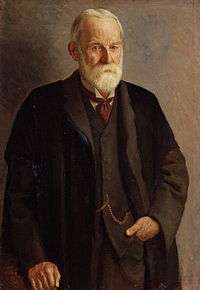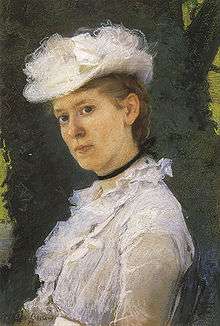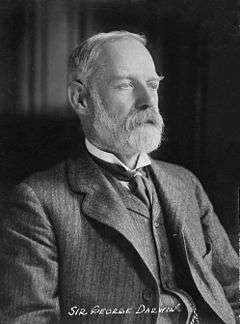George Darwin
| Sir George Howard Darwin | |
|---|---|
|
Sir George Howard Darwin | |
| Born |
George Howard Darwin 9 July 1845 Down House, Downe, Kent, England |
| Died |
7 December 1912 (aged 67) Cambridge, England |
| Nationality | British |
| Fields | Astronomy and mathematics |
| Alma mater |
St John's College, Cambridge Trinity College, Cambridge |
| Academic advisors | Edward John Routh |
| Notable students |
Ernest William Brown E. T. Whittaker |
| Notable awards |
Smith's Prize (1868) Royal Medal (1884) Gold Medal of the Royal Astronomical Society (1892) Copley Medal (1911) |
|
Signature | |
Sir George Howard Darwin KCB FRS FRSE (9 July 1845 – 7 December 1912)[1] was an English barrister, eugenicist, astronomer and mathematician.
Biography


George Darwin was born at Down House, Kent, the second son and fifth child of Charles and Emma Darwin.
From the age of 11 he studied under Charles Pritchard at Clapham Grammar School, and entered St John's College, Cambridge, in 1863, though he soon moved to Trinity College,[2] where his tutor was Edward John Routh. He graduated as second wrangler in 1868, when he was also placed second for the Smith's Prize and was appointed to a college fellowship. He was admitted to the bar in 1872, but returned to science.[2] He was elected a Fellow of the Royal Society in June 1879 and won their Royal Medal in 1884 and their Copley Medal in 1911.[3] He delivered their Bakerian Lecture in 1891 on the subject of "tidal prediction".
In 1883 Darwin became Plumian Professor of Astronomy and Experimental Philosophy at the University of Cambridge. He studied tidal forces involving the Sun, Moon, and Earth, and formulated the fission theory of Moon formation.[4]
Darwin was a Fellow of the Royal Astronomical Society (RAS) and won the Gold Medal of the RAS in 1892. From 1899–1901 he served as President of the RAS. The RAS founded a prize lectureship in 1984 and named it the George Darwin Lectureship in Darwin's honour.
He was an invited speaker in the International Congress of Mathematicians 1908, Rome on the topic of "Mechanics, Physical Mathematics, Astronomy."[5] As President of the Cambridge Philosophical Society, he also gave the Introductory Address to the Congress in 1912 on the character of pure and applied mathematics.[6]
He is buried in Trumpington Extension Cemetery in Cambridge with his son Leonard and his daughter Gwen (Raverat), his wife Lady Maud Darwin was cremated at Cambridge Crematorium; his brothers Sir Francis Darwin and Sir Horace Darwin and their respective wives are interred in the Parish of the Ascension Burial Ground.
Family
Darwin married Martha (Maud) du Puy, the daughter of Charles du Puy of Philadelphia, in 1884; his wife was a member of the Ladies Dining Society in Cambridge, with 11 other members.
She died on 6 February 1947. They had three sons and two daughters:
- Gwen Raverat (1885–1957), artist.
- Charles Galton Darwin (1887–1962), physicist and applied mathematics.
- Margaret Elizabeth Darwin (1890–1974), married Sir Geoffrey Keynes.
- William Robert Darwin (1894–1970)
- Leonard Darwin (1899–1899)
Ancestry
| Ancestors of George Darwin | ||||||||||||||||||||||||||||||||||||||||||||||||||||||||||||||||||||||||||||||||||||||||||||||||||||||||||||||||||||||||||||||||||||||||||||||||||||||||||||||||||||||||||||||||||||||||||||||||||||||||||||||||||||||||||||||||||||||||||||||||||||||||||||||||||||||||||||||||||||||||||||||||||||||||||||||||||||||||||||||||||||||||||||||||||||||||||||||||||||||||||||||||||||||||||||||||||||||||||||||||||||||||||||||||||||||||||||||||||||||||||||||||||||||||||||||||||||||||||||||||||||||||||||||||||||||||||||||||||
|---|---|---|---|---|---|---|---|---|---|---|---|---|---|---|---|---|---|---|---|---|---|---|---|---|---|---|---|---|---|---|---|---|---|---|---|---|---|---|---|---|---|---|---|---|---|---|---|---|---|---|---|---|---|---|---|---|---|---|---|---|---|---|---|---|---|---|---|---|---|---|---|---|---|---|---|---|---|---|---|---|---|---|---|---|---|---|---|---|---|---|---|---|---|---|---|---|---|---|---|---|---|---|---|---|---|---|---|---|---|---|---|---|---|---|---|---|---|---|---|---|---|---|---|---|---|---|---|---|---|---|---|---|---|---|---|---|---|---|---|---|---|---|---|---|---|---|---|---|---|---|---|---|---|---|---|---|---|---|---|---|---|---|---|---|---|---|---|---|---|---|---|---|---|---|---|---|---|---|---|---|---|---|---|---|---|---|---|---|---|---|---|---|---|---|---|---|---|---|---|---|---|---|---|---|---|---|---|---|---|---|---|---|---|---|---|---|---|---|---|---|---|---|---|---|---|---|---|---|---|---|---|---|---|---|---|---|---|---|---|---|---|---|---|---|---|---|---|---|---|---|---|---|---|---|---|---|---|---|---|---|---|---|---|---|---|---|---|---|---|---|---|---|---|---|---|---|---|---|---|---|---|---|---|---|---|---|---|---|---|---|---|---|---|---|---|---|---|---|---|---|---|---|---|---|---|---|---|---|---|---|---|---|---|---|---|---|---|---|---|---|---|---|---|---|---|---|---|---|---|---|---|---|---|---|---|---|---|---|---|---|---|---|---|---|---|---|---|---|---|---|---|---|---|---|---|---|---|---|---|---|---|---|---|---|---|---|---|---|---|---|---|---|---|---|---|---|---|---|---|---|---|---|---|---|---|---|---|---|---|---|---|---|---|---|---|---|---|---|---|---|---|---|---|---|---|---|---|---|---|---|---|---|---|---|---|---|---|---|---|---|---|---|---|---|---|---|---|---|---|---|---|---|---|---|---|---|---|---|---|---|---|---|---|---|---|---|---|---|---|---|---|---|---|---|---|---|---|---|---|---|---|---|---|---|---|---|---|---|---|---|---|---|---|---|---|---|---|---|---|---|---|---|---|---|---|---|---|---|---|---|---|---|---|---|---|---|---|---|---|---|---|---|---|---|---|---|---|---|---|---|---|---|---|---|
| ||||||||||||||||||||||||||||||||||||||||||||||||||||||||||||||||||||||||||||||||||||||||||||||||||||||||||||||||||||||||||||||||||||||||||||||||||||||||||||||||||||||||||||||||||||||||||||||||||||||||||||||||||||||||||||||||||||||||||||||||||||||||||||||||||||||||||||||||||||||||||||||||||||||||||||||||||||||||||||||||||||||||||||||||||||||||||||||||||||||||||||||||||||||||||||||||||||||||||||||||||||||||||||||||||||||||||||||||||||||||||||||||||||||||||||||||||||||||||||||||||||||||||||||||||||||||||||||||||
Works by G. H. Darwin
- "Tides" (Encyclopædia Britannica, Ninth Edition, 1875–89)
- The tides and kindred phenomena in the solar system (Boston, Houghton, 1899)
- Problems connected with the tides of a viscous spheroid (London, Harrison and Sons, 1879–1882)
- Scientific papers (Volume 1): Oceanic tides and lunar disturbances of gravity (Cambridge : University Press, 1907)[7][8]
- Scientific papers (Volume 2): Tidal friction and cosmogony. (Cambridge : University Press, 1908)[7]
- Scientific papers (Volume 3): Figures of equilibrium of rotating liquid and geophysical investigations. (Cambridge : University Press, 1908)
- Scientific papers (Volume 4): Periodic orbits and miscellaneous papers. (Cambridge : University Press, 1911)
- Scientific papers (Volume 5) Supplementary volume, containing biographical memoirs by Sir Francis Darwin and Professor E. W. Brown, lectures on Hill's lunar theory, etc... (Cambridge : University Press, 1916)
- The Scientific Papers of Sir George Darwin. 1907. Cambridge University Press (rep. by Cambridge University Press, 2009; ISBN 978-1-108-00449-7)
Articles
- "On Beneficial Restrictions to Liberty of Marriage," The Contemporary Review, Vol. XXII, June/November 1873.
- "Commodities Versus Labour," The Contemporary Review, Vol. XXII, June/November 1873.
- "The Birth of a Satellite" Harper's Monthly Magazine, December 1903, pages 124 to 130.
References
- ↑ GRO Register of Deaths: DEC 1912 3b 552 CAMBRIDGE – George H. Darwin, aged 67
- 1 2 "Darwin, George Howard (DRWN863GH)". A Cambridge Alumni Database. University of Cambridge.
- ↑ "Library and Archive Catalogue". Royal Society. Retrieved 29 December 2010.
- ↑ Britannica.com: Sir George Darwin
- ↑ "ICM Plenary and Invited Speakers since 1897". International Congress of Mathematicians.
- ↑ Hobson, E. B. and A. E. H. Love, eds. (1913). Proceedings of the Fifth International Congress of Mathematicians (Cambridge, 22-28 August 1912). Cambridge: Cambridge University Press. pp. 33–36.
- 1 2 Brown, Ernest W. (1909). "Review: Scientific Papers, by George Howard Darwin". Bull. Amer. Math. Soc. 16 (2): 73–78. doi:10.1090/s0002-9904-1909-01862-2.
- ↑ "Review: Scientific Papers. Vol. I by Sir George Howard Darwin". The Athenaeum (4196): 386. March 28, 1908.
External links
| Wikisource has the text of a 1905 New International Encyclopedia article about George Darwin. |
- Works by George Darwin at Project Gutenberg
- Works by or about George Darwin at Internet Archive
- O'Connor, John J.; Robertson, Edmund F., "George Darwin", MacTutor History of Mathematics archive, University of St Andrews.
- George Howard Darwin at the Mathematics Genealogy Project
- "The Genesis of Double Stars" – by George Darwin, from A.C. Seward's Darwin and Modern Science (1909).
- "Archival material relating to George Darwin". UK National Archives.
- details of correspondence
- Trinity College Chapel memorial
- George Darwin at Find a Grave
